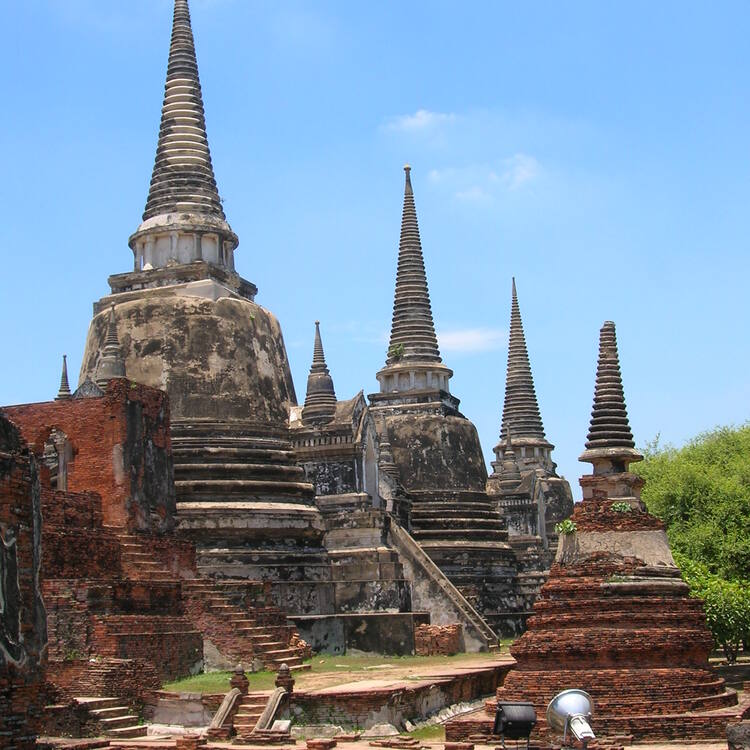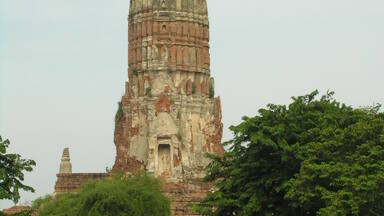Historic City of Ayutthaya
Historic City of Ayutthaya
Founded c. 1350, Ayutthaya became the second Siamese capital after Sukhothai. It was destroyed by the Burmese in the 18th century. Its remains, characterized by the prang (reliquary towers) and gigantic monasteries, give an idea of its past splendour.
Description is available under license CC-BY-SA IGO 3.0
Ville historique d’Ayutthaya
Fondée vers 1350, Ayutthaya devint la deuxième capitale siamoise après Sukhothaï. Elle fut détruite par les Birmans au XVIIIe siècle. Ses vestiges, caractérisés par les prangs, ou tours-reliquaires, et par des monastères aux proportions gigantesques, donnent une idée de sa splendeur passée.
Description is available under license CC-BY-SA IGO 3.0
مدينة أيوتايا التاريخية
أصبحت أيوتايا التي أبصرت النور حوالى عام 1350 العاصمة الثانية لمملكة سيام بعد سوكوتاي، قبل ان يدمرها البرمانيون في القرن الثامن عشر. أما آثارها التي تتميز بوجود الأبراج المروّسة أو أبراج الذخائر الضخمة وأديرة ذات مقاييس هائلة فتقدّم فكرة عن روعتها السابقة.
source: UNESCO/CPE
Description is available under license CC-BY-SA IGO 3.0
阿育他亚(大城)历史城及相关城镇
阿育他亚(大城)是继素可泰(Sukhothai)之后的第二任暹罗首府,大约建于1350年,18世纪被缅甸人摧毁。它的遗迹圣骨塔和大清真寺至今还依稀显露出其昔日的辉煌。
source: UNESCO/CPE
Description is available under license CC-BY-SA IGO 3.0
Исторический город Аютия и соседние исторические города
Основанная в 1350-х гг., Аютия стала второй сиамской столицей после Сукотаи. Она была разрушена бирманцами в XVIII в. Руины Аютии с характерными священными башнями – «прангами» и огромными монастырями дают представление о ее былом величии.
source: UNESCO/CPE
Description is available under license CC-BY-SA IGO 3.0
Ciudad histórica de Ayutthaya
Fundada hacia el año 1350, Ayutthaya fue la segunda capital de Siam después de Sukhotai. En el siglo XVIII fue destruida por los birmanos. Sus vestigios, entre los que destacan las prang (torres-relicarios) y varios monasterios de proporciones gigantescas, permiten hacerse una idea de su esplendoroso pasado.
source: UNESCO/CPE
Description is available under license CC-BY-SA IGO 3.0
古都アユタヤ
バンコクの北約90km。アンコールの遺産を継承したアユタヤ朝の首都。インドシナ最大の都市として14世紀から400年にわたり繁栄し、「黄金の都」と称された。象徴的存在のワット・シー・サンペット、ワット・プラ・ラムなどの重要な寺院跡や王宮跡が、周辺の歴史地区にはワット・プーカオ・トーンやモン様式の仏塔などが今も残る。街区南には日本人街が残る。アユタヤは「難攻不落」の意だが、1767年ビルマ軍の攻撃で陥落した。source: NFUAJ
Historische stad Ayutthaya
Ayutthaya werd omstreeks 1350 gesticht en was de tweede Siamese hoofdstad na Sukhothai. De stad groeide van de 14e tot de 18e eeuw uit tot een van de grootste, meest kosmopolitische stedelijke gebieden ter wereld en was een centrum van mondiale diplomatie en handel. Ayutthaya lag op een eiland omringd door drie rivieren, verbonden met de zee. De Birmezen verwoestten de stad in de 18e eeuw. De overblijfselen worden gekenmerkt door de prang (reliekschrijn torens) en gigantische kloosters, die een goede indruk geven van de vroegere pracht en praal.
Source: unesco.nl
Outstanding Universal Value
Brief synthesis
The Historic City of Ayutthaya, founded in 1350, was the second capital of the Siamese Kingdom. It flourished from the 14th to the 18th centuries, during which time it grew to be one of the world’s largest and most cosmopolitan urban areas and a center of global diplomacy and commerce. Ayutthaya was strategically located on an island surrounded by three rivers connecting the city to the sea. This site was chosen because it was located above the tidal bore of the Gulf of Siam as it existed at that time, thus preventing attack of the city by the sea-going warships of other nations. The location also helped to protect the city from seasonal flooding.
The city was attacked and razed by the Burmese army in 1767 who burned the city to the ground and forced the inhabitants to abandon the city. The city was never rebuilt in the same location and remains known today as an extensive archaeological site.
At present, it is located in Phra Nakhon Si Ayutthaya District, Phra Nakhon Si Ayutthaya Province. The total area of the World Heritage property is 289 ha.
Once an important center of global diplomacy and commerce, Ayutthaya is now an archaeological ruin, characterized by the remains of tall prang (reliquary towers) and Buddhist monasteries of monumental proportions, which give an idea of the city’s past size and the splendor of its architecture.
Well-known from contemporary sources and maps, Ayutthaya was laid out according to a systematic and rigid city planning grid, consisting of roads, canals, and moats around all the principal structures. The scheme took maximum advantage of the city’s position in the midst of three rivers and had a hydraulic system for water management which was technologically extremely advanced and unique in the world.
The city was ideally situated at the head of the Gulf of Siam, equi-distant between India and China and well upstream to be protected from Arab and European powers who were expanding their influence in the region even as Ayutthaya was itself consolidating and extending its own power to fill the vacuum left by the fall of Angkor. As a result, Ayutthaya became a center of economics and trade at the regional and global levels, and an important connecting point between the East and the West. The Royal Court of Ayutthaya exchanged ambassadors far and wide, including with the French Court at Versailles and the Mughal Court in Delhi, as well as with imperial courts of Japan and China. Foreigners served in the employ of the government and also lived in the city as private individuals. Downstream from the Ayutthaya Royal Palace there were enclaves of foreign traders and missionaries, each building in their own architectural style. Foreign influences were many in the city and can still be seen in the surviving art and in the architectural ruins.
The Ayutthaya school of art showcases the ingenuity and the creativity of the Ayutthaya civilization as well as its ability to assimilate a multitude of foreign influences. The large palaces and the Buddhist monasteries constructed in the capital, for example at Wat Mahathat and Wat Phra Si Sanphet, are testimony to both the economic vitality and technological prowess of their builders, as well as to the appeal of the intellectual tradition they embodied. All buildings were elegantly decorated with the highest quality of crafts and mural paintings, which consisted of an eclectic mixture of traditional styles surviving from Sukhothai, inherited from Angkor, and borrowed from the 17th and 18th century art styles of Japan, China, India, Persia and Europe, creating a rich and unique expression of a cosmopolitan culture and laying the foundation for the fusion of styles of art and architecture popular throughout the succeeding Rattanakosin Era and onwards.
Indeed, when the capital of the restored kingdom was moved downstream and a new city built at Bangkok, there was a conscious attempt to recreate the urban template and architectural form of Ayutthaya. Many of the surviving architects and builders from Ayutthaya were brought in to work on building the new capital. This pattern of urban replication is in keeping with the urban planning concept in which cities of the world consciously try to emulate the perfection of the mythical city of Ayodhaya. In Thai, the official name for the new capital at Bangkok retains “Ayutthaya” as part of its formal title.
Criterion (iii): The Historic City of Ayutthaya bears excellent witness to the period of development of a true national Thai art.
Integrity
The integrity of the property as the ruins of the former Siamese capital is found in the preservation of the ruined or reconstructed state of those physical elements which characterized this once great city. These consist of first and foremost the urban morphology, the originality of which is known from contemporary maps of the time prepared by several of the foreign emissaries assigned to the Royal Court. These maps reveal an elaborate, but systematic pattern of streets and canals throughout the entire island and dividing the urban space into strictly controlled zones each with its own characteristic use and therefore architecture. The urban planning template of the entire island remains visible and intact, along with the ruins of all the major temples and monuments identified in the ancient maps. Wherever the ruins of these structures had been built over after the city was abandoned, they are now uncovered.
In addition, the ruins of all the most important buildings have been consolidated, repaired and sometimes reconstructed.
The designated area of the World Heritage property, which is confined to the former Royal Palace precinct and its immediate surrounding and covers the most important sites and monuments and ensures the preservation of the property’s Outstanding Universal Value. Initially it was intended to manage the remaining historic monuments through complementary planning and protection controls, however, present economic and social factors warrant an extension of the historical park to cover the whole of Ayutthaya Island for the protection of all associated ancient monuments and sites as well as to strengthen the integrity of the World Heritage property. Extending the boundaries of the World Heritage property to include the whole of Ayutthaya Island will bring the boundaries of the property into exact conformity with those of the historic city.
Authenticity
The Historic City of Ayutthaya is well-known from historical records. As one of the world’s largest cities of its time and a major political, economic and religious center, many visitors recorded facts about the city and their experiences there. The Siamese Royal Court also kept meticulous records; many were destroyed in the sack of the city, but some have remained and are an important source of authenticity. The same can be said for the testimony of works of art, wall painting, sculpture, and palm leaf manuscripts which survive from the period. Of particular note are the surviving mural paintings in the crypt of Wat Ratchaburana. Careful attention to the accurate interpretation of the ruins to the public for educational purposes also contributes to the property’s authenticity.
Protection and management requirements
The Historic City of Ayutthaya is managed as a historical park. It is gazetted and protected by Thai law under the Act on Ancient Monuments, Antiques, Objects of Art and National Museums, B.E. 2504 (1961) as amended by Act (No.2), B.E. 2535 (1992), enforced by the Fine Arts Department, Ministry of Culture. There are other related laws enforced by related government units such as the Ratchaphatsadu Land Act, B.E. 2518 (1975), the City Planning Act B.E. 2518 (1975), the Enhancement and Conservation of National Environmental Quality Act, B.E. 2535 (1992), the Building Control Act B.E. 2522 (1979) as amended by Act No. 2, B.E. 2535 (1992), and municipal regulations.
In addition to formal legal protection, there is a Master Plan for the property which has Cabinet approval. Committees for the protection and development of the Historic City of Ayutthaya at the national and local and levels have been established and there are a number of special-interest heritage conservation groups among the non-governmental community.
The budget for the conservation and development of the Historic City of Ayutthaya is allocated by the Government and the private sector.
An extension of the World Heritage property is under preparation which will cover the complete footprint of the city of Ayutthaya as it existed in the 18th century, when it was one of the world’s largest urban areas. This will bring other important ancient monuments, some of which are outside of the presently-inscribed area under the same protection and conservation management afforded to the current World heritage property. In addition, new regulations for the control of construction within the property’s extended boundaries are being formulated to ensure that the values and views of the historic city are protected. With these changes, all new developments in the modern city of Ayutthaya will be directed to areas outside of the historic city’s footprint and the inscribed World Heritage property.

 View photos from OUR PLACE the World Heritage collection
View photos from OUR PLACE the World Heritage collection




